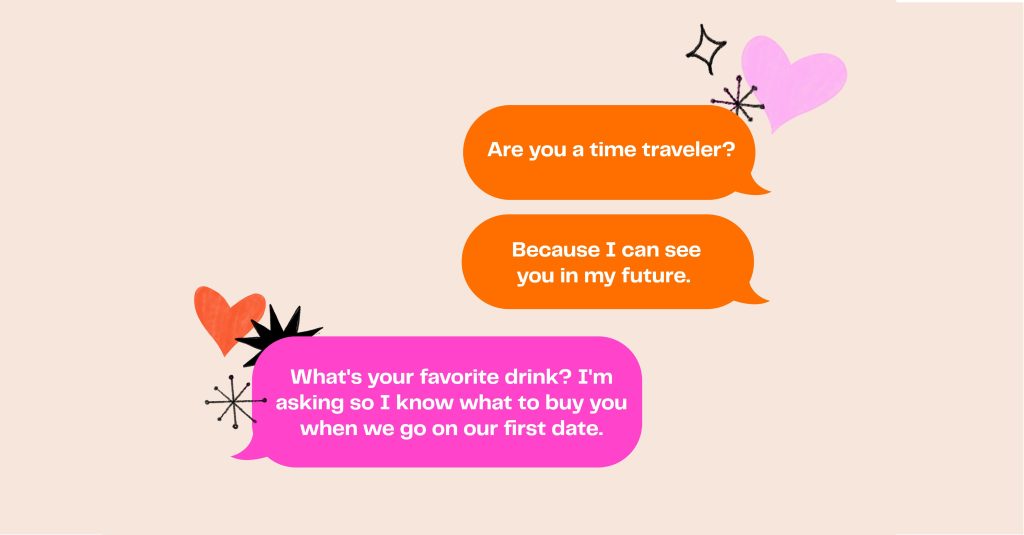Flirtatious banter examples are a fun and effective way to spark chemistry and keep conversations exciting. Whether you’re texting, chatting in person, or flirting online, playful banter allows you to show interest without coming on too strong.
By teasing lightly, sharing witty remarks, and adding subtle compliments, you can create a magnetic, engaging interaction that draws someone in. These examples aren’t just random lines—they’re tools to help you build rapport, make the other person smile, and keep the conversation lively.
Learning how to use flirtatious banter confidently can turn ordinary conversations into memorable moments, leaving a lasting impression while keeping the mood playful and flirty.

Table of Contents
What Is Flirty Banter and Why Does It Matter?
Flirty banter is the playful and often witty exchange between two people that sparks romantic interest or emotional connection. It uses humor, teasing, and lighthearted remarks to establish rapport and showcase a good personality without coming off as serious or intense.
Flirty banter is important because it helps both individuals test the waters of attraction and compatibility in a relaxed way. Many people on Quora and other dating platforms ask about the art of playful banter because it’s frequently misunderstood or underutilized.
Knowing how to use this skill lets you keep the conversation light and fun while also building genuine connection. Plus, when done well, it signals confidence, creativity, and emotional intelligence—all attractive traits.
How Can You Master the Art of Playful Banter?
- To master the art of playful banter, you first need to know how to banter with a guy or anyone you’re interested in.
- This involves understanding tone of voice, timing, and the subtle balance between teasing and sincerity.
- Being too harsh can hurt feelings, while being too cautious may make the conversation dull.
- The key is to keep the banter light and playful, using spontaneity and a warm tone to show interest without overwhelming the other person.
- When you master the art, you’ll find yourself able to switch between witty banter and sweet talk easily, making interactions feel natural and enjoyable.
- Remember, the goal is to build attraction while having fun, not to insult or take things too seriously.
What Are Effective Banter Examples to Use?
- Effective banter examples typically involve playful teasing, clever comebacks, and humorous observations that invite a response.
- For instance, if someone jokes about being bad at cooking, a playful banter comeback might be, “Good thing you’re charming enough to get by on good looks alone!”
- Banter can also be witty repartee, where each person builds on the other’s remarks to create a fun, back-and-forth dynamic.
- Using lighthearted jokes or even cheesy pickup lines can help break the ice, as long as they are delivered with the right tone and confidence.
- Including small talk topics with a twist of humor keeps the conversation moving and makes your personality shine.
How Do You Flirt Without Taking Things Too Seriously?
Flirting through banter works best when you don’t take it too seriously. Overanalyzing every word or trying to impress can stifle spontaneity. Instead, approach banter with a mindset to simply have fun and be playful. This lighthearted attitude invites natural chemistry to develop.
Playful banter allows you to subtly signal your interest without explicit declarations. Instead of heavy romantic talk, you rely on teasing and humor to build emotional tension. If the other person responds well, you know there is potential. If not, you keep it light and respectful without hurtful comments or overstepping boundaries.

What Role Does Playful Teasing Play in Flirty Banter?
Playful teasing is one of the most effective tools in the art of banter. It shows confidence and allows you to create inside jokes or shared experiences quickly. Teasing, when done right, is never meant to insult but to create a light spark that keeps the interaction exciting.
Using playful teasing can also be a way to test if someone is interested in you romantically. If they tease back, it’s a good sign there’s mutual attraction. However, knowing how to banter means recognizing when to stop so it doesn’t turn hurtful or annoying. The balance is learning to be witty, not mean.
How Do Emojis and GIFs Enhance Text Banter?
In the digital age, text banter often involves emojis and GIFs, which add emotional context and help convey tone that plain text sometimes lacks. A well-placed emoji can soften a tease or highlight flirtatious intent without sounding too serious.
For example, a wink emoji after a flirty tease signals playfulness and interest, while a GIF can add humor or a cheeky response. Using emojis strategically keeps the conversation dynamic and engaging, making your playful banter come alive even through a screen. Knowing when and how to use them demonstrates a good understanding of text communication nuances.
What Is the Difference Between Flirty Banter and Negging?
Negging is a controversial technique that involves backhanded compliments or light insults to lower someone’s confidence while appearing playful. While some confuse negging with playful banter, the latter focuses on mutual fun and respect, whereas negging can be hurtful and manipulative.
The art of playful banter means avoiding negging because it damages rapport and trust. Genuine flirty banter builds attraction through positive humor and shows you have a sincere interest, not just trying to undermine the other person’s self-esteem. If you’re unsure about crossing the line, it’s best to stick with light and playful teasing.
How Can You Use Banter to Build Attraction and Rapport?
Banter is an excellent way to build attraction and initial rapport quickly by showing off your good personality and making interactions enjoyable. When you know how to banter with someone and keep the conversation flowing naturally, you create emotional connection beyond just physical looks.
Playfully flirting using clever responses and sweet talk signals that you’re interested without being overbearing. It helps foster chemistry because it makes the other person feel special and entertained. Rapport formed through well-executed banter sets a strong foundation for deeper conversations later on.
How Do You Respond to Banter Confidently?
- Responding to banter confidently requires quick thinking and an open mind.
- When someone throws a playful tease or flirty remark your way, don’t take it personally or freeze up.
- Instead, embrace the repartee by responding with a witty comeback or playful joke.
- Confidence in banter isn’t about being perfect but showing you can take a joke and keep the tone light.
- Using humor and emojis helps signal that you’re engaged.
- Sometimes, responding with a well-timed “ouch!” or a mock insult can be charming if done with the right facial expression or tone of voice.
When Should You Take It Slow in Flirty Conversations?
While quick wit is great, sometimes it’s wise to take it slow in flirty conversations, especially when you’re just establishing initial rapport. Not everyone gets flirty banter immediately, and overwhelming with relentless teasing or sexual connotation too soon can backfire.
Taking it slow means balancing playful teasing with meaningful small talk and knowing when to switch gears into sweet talk or deeper subjects. Reading body language or digital cues like emoji use can guide you on the right pace. This ensures you build a solid foundation before escalating intimacy or making physical contact.

FAQs
What are examples of flirty behavior?
Flirty behavior is playful or romantic communication intended to show interest. Examples include:
Playful teasing or joking
Light compliments (e.g., “You have the best smile”)
Subtle touches (like a hand on the arm)
Sustained eye contact and smiling
Playful banter and laughter
Mirroring body language
How to flirt smoothly – examples via text?
Smooth texting is playful, light, and confident. Examples:
Compliment + playful twist: “Stop being so charming… it’s unfair 😏”
Light teasing: “I bet you can’t beat me at trivia tonight 😎”
Playful curiosity: “So… when are you taking me to your favorite café?”
Subtle hint: “I was just thinking about someone who makes me laugh a lot… guess who? 😉”
What is the most flirty thing to say?
The most flirty lines are often playful and suggestive, without being crude. Examples:
“Are you always this irresistible, or is it just me?”
“I can’t tell if I’m smiling because of you or at you 😏”
“You’re dangerously charming, you know that?”
What is playful flirty?
Playful flirting is lighthearted, teasing, and fun without pressure. It’s about showing interest while keeping the interaction fun.
Example: Making a joking bet: “If I win this game, you owe me a coffee ☕😏”
Sending memes or GIFs that hint at attraction
What are the 5 styles of flirting?
According to research by psychologist Desmond Morris, the five flirting styles are:
Physical – Touch, closeness, sexual signals
Playful – Teasing, joking, banter
Polite – Respectful, subtle, courteous interest
Sincere – Compliments, heartfelt expressions of interest
Traditional – Following traditional gender roles and courtship signals
What is an example of inappropriate flirting?
Inappropriate flirting crosses boundaries, is unwelcome, or sexualizes someone without consent. Examples:
Making sexual comments at work
Touching without consent
Persistent messaging after being asked to stop
Using offensive or degrading language
What is the most flirty emoji?
The most commonly flirty emoji are:
😏 (Smirking face – suggestive)
😉 (Winking face – playful)
😘 (Kissing face)
❤️ or 💕 (Heart emojis for romantic interest)
What are the three phases of flirting?
Flirting often unfolds in three phases:
Initial attention – Eye contact, smiles, subtle signals
Interaction and rapport – Playful conversation, teasing, humor
Escalation or exit – Physical touch, intimate conversation, or graceful exit if uninterested
Summary: Key Points to Remember
- Flirty banter is a playful and witty way to build attraction and rapport without taking things too seriously.
- Mastering the art of playful banter involves balance, tone of voice, spontaneity, and knowing when to stop teasing.
- Use lighthearted teasing and clever comebacks as effective banter examples to keep conversations engaging.
- Emojis and GIFs enhance text banter by conveying tone and adding fun to the conversation.
- Avoid negging; instead, focus on humor that lifts up, not insults or hurts.
- Respond to banter confidently by embracing repartee and showing your good personality.
- Take it slow when starting flirty conversations to respect boundaries and build true connection.
- The art of banter helps you keep the conversation alive, build attraction, and ultimately flirt with effortless charm.
By applying these principles, you can transform casual chat into an exciting game of flirtatious connection, mastering the art of playful banter for meaningful and fun relationships.
Conclusion
Mastering flirtatious banter is all about combining playfulness, wit, and subtle charm. By using light teasing, clever jokes, and thoughtful compliments, you can turn ordinary conversations into engaging, flirty exchanges that spark attraction and build rapport.
The key is to keep interactions fun, confident, and respectful, ensuring the other person feels comfortable while enjoying the playful energy. Whether it’s in person or through text, practicing these examples helps you become more confident, spontaneous, and charming.
Remember, the goal is connection, not pressure—flirtatious banter works best when it feels natural and mutual. With consistent practice, anyone can elevate their social interactions and make meaningful, playful connections.